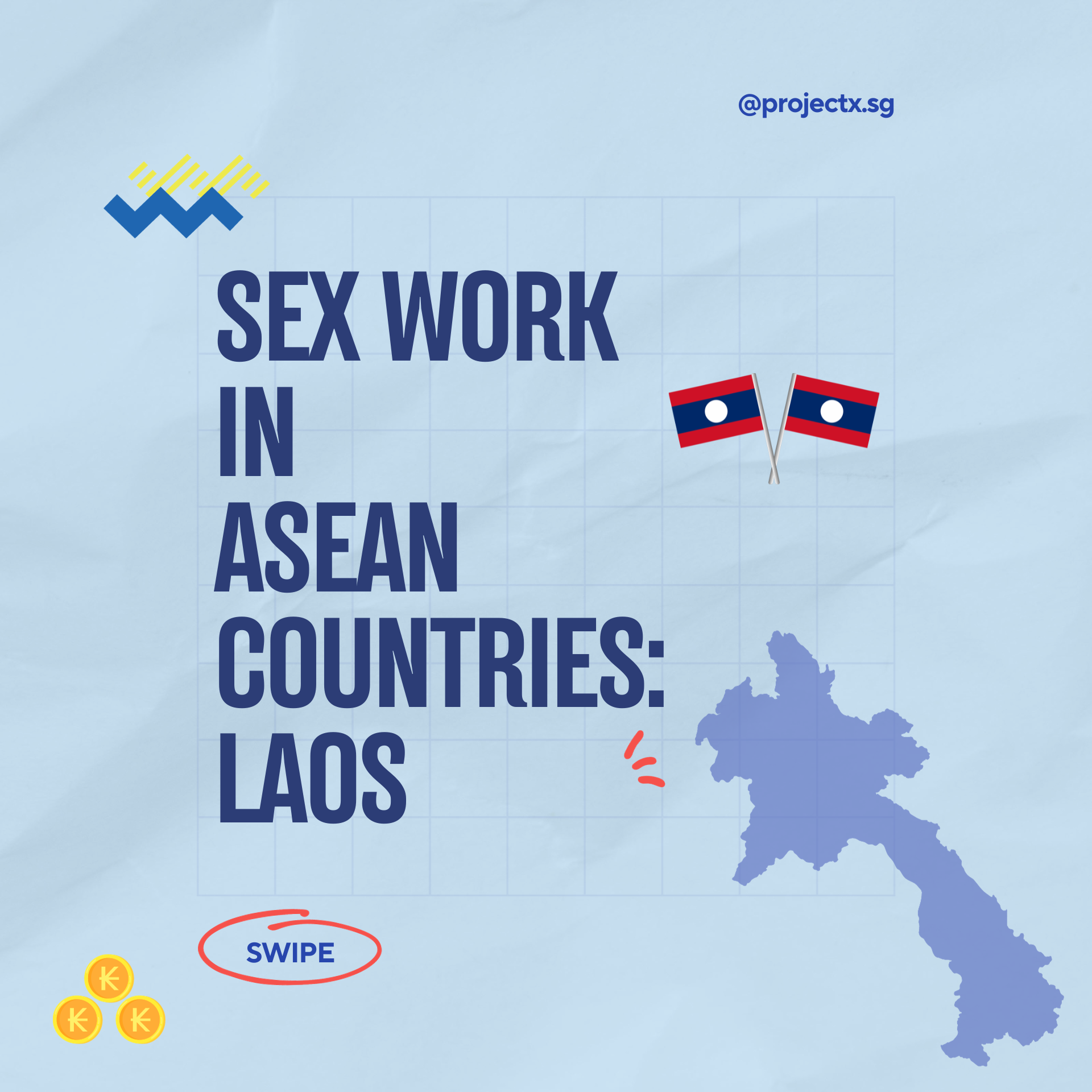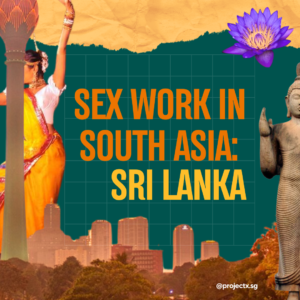Preface
Our latest addition to the Sex Work in ASEAN Countries series, this post will expound upon the state of the sex industry and sex workers’ rights in Laos. It will also touch on the history and economic impact of sex work, sex work statistics, sex work in Laos’ cultural context, and finally, the future of the industry in Laos.
A Brief History of Sex Work in Laos
To preface, there is a dearth of sufficient and in-depth research about sex work in Laos, in both quantitative and qualitative ways, since sex work is banned in Laos and there is a taboo surrounding it.
Click on our visual below to learn about the development of the profession in Laos!
Law, Policy, and Policing
Under Article 260 of the Lao PDR Penal Code, “Any person engaging in prostitution shall be sentenced to imprisonment for a term ranging from three months to one year or by re-education without deprivation of liberty and a fine shall be imposed ranging from 500,000 kip to 3,000,000 kip. (SGD 33 to SGD 199) ” On the other hand, any person “assisting or facilitating prostitution shall be sentenced to imprisonment for a term ranging from three months to one year or re-education without deprivation of liberty and a fine shall be imposed ranging from 5,000,000 kip to 15,000,000 kip (SGD 332 to SGD 995)”. Any person who purchases sexual services shall also be punished under the same charge. Hence, sex work is illegal in Laos, and offenders are subject to severe prosecution.
In 2021, more than sixty sex workers and brothel owners in Sikhottabong District, Vientiane (the capital of Laos) were “disciplined” and warned by the police to cease the provision of sex work, and to find new jobs. According to the Vientiane Capital Public Security Office, nine restaurants and entertainment venues were found to be functioning as illegal brothels.
Located at the intersection of the Mekong River, involving Laos, Thailand, and China, the Golden Triangle Special Economic Zone (GTSEZ) was created as an entertainment and tourism hub. The main clientele in the GTSEZ are Chinese men. An impact of the GTSEZ is a rise in the demand for commercial sex. Sex work operating in the GTSEZ is often overlooked due to the limited control the Laotian government has overseeing the GTSEZ. Lyttleton and Vorabouth (2011) note that while one cannot suggest the presence of Chinese men as the sole reason for increased scale and profile of sex venues as Lao (and Thai) men are also patrons.
Sex trafficking in Laos is also a problem. Many Laotian teenage girls are being lured into China hoping to find rich husbands, only to be sold to brothels or coerced into being a street-based sex worker. Under Article 215 and Article 253 of the Laos Penal Code, forcing a person into sex work can face a penalty of five to ten years imprisonment, with a fine up to 20,000,000 Laotian Kip (SGD 1326), and if the coerced person is a minor, the imprisonment term can be up 10 to 20 years, with a fine up to 50,000,000 Laotian Kip (SGD 3314). Anyone found profiting from procuring sex work can be punished with six months to three years of imprisonment too.
The trafficking of any person into any job is a gross violation of human rights, including any trafficking into the sex industry. At the same time, it is also crucial that we develop a more careful approach to distinguishing between sex work and trafficking. Failure to distinguish (such as calling all migratory sex work ‘trafficking’) only further constrains the ability of sex workers to operate and makes them vulnerable to disproportionate abuse.
Sex Worker Statistics and their Economic Impact
Although rarely reported in the media, Laos, with its limited population and widespread poverty, has a growing sex industry within its borders. As of 2022, UNAIDS estimated a total of 16,900 female sex workers in Laos, an increase from 14,000 back in 2018. It is also projected that there are as many as three times that figure operating independently throughout the country. Despite sex work being illegal in Laos, the industry is prevalent across the landscape. There are generally two types of sex workers in Laos, street-based and venue-based. Venue-based sex workers are officially employed as hostesses to work in entertainment places (e.g. beer bars ‘drink shops’, karaoke bars, nightclubs, guesthouses and restaurants) to provide services to clients in the form of serving beer, snacks and conversation but also selling sex (National Committee for the Control of AIDS Bureau (NCCAB), 2005). Instead of overtly advertising their adult services, sex workers initially provide hostess services. The sex workers posing as sao borigan, or beer hostess, get a commission from the beers consumed, so the increase in beer consumption entitles the customer to an increase in physical intimacy with the sao borigan. Eventually, the drinking session might lead to the couple negotiating the terms for sexual services to take place elsewhere, commonly in a nearby guesthouse. Venue-based sex workers find clients through pimps and provide sexual services in guesthouses, hotels, or the client’s room, which are usually attached to entertainment places.
Despite the illegality and taboo, some of these women believe that sex work is the best economic opportunity for them, according to a survey conducted with sex workers in 2006 in Vientiane. Most sex workers in Laos are from poverty-stricken, rural Laotian families, especially the ethnic minorities. One of the main minority groups in Laos, the Khmu, is overrepresented among Lao sex workers.
While some sex workers would choose to do sex work in Laos, others choose to provide their services in Thailand. The Thai Baht along with the American Dollar is an accepted currency in Laos. The Thai-Lao border along the Mekong River share strong cultural, linguistic, and kinship ties. Contrary to what one might expect, prices for commercial sex are similar on both sides of the border, and in many cases, they are even more expensive in Laos than in Nong Kai, Thailand. Short time costs around 352 000 KIP (SGD 24) (including the commission price owed to the beer shop owners) in a beer shop in Vientiane and 700 baht (SGD26) in off-site brothel networks in Nong Kai, Thailand. However, sex workers in Vientiane can often negotiate higher prices. Sex workers commonly charge 500 baht for “short term” and 1000 – 1500 baht for “long term” services. To caveat, sex workers’ incomes are subject to considerable fluctuation depending on the clients encountered.
Culture, Religion, and Social Norms
Buddhism serves as the cornerstone of Laos’ gender ideology, in which women ought to take on a lesser and inferior role to men in society. Even under Siam and French colonisation, Laos women were deemed as second class citizens. Under Buddhism, the idea of karma instils a self-policing mindset for people to regulate their own actions as it would determine whether they would be punished or rewarded. This sets the precedence for sex work in Laos to be stigmatised, and for sex workers to be exploited in such a society.
Despite economic development, traditional culture and gender norms remain conservative. For example, pre- and extramarital sexuality is discouraged for women. On the other hand, it is widely accepted for men, whose sexual needs are perceived as normal and natural. This highlights the discrepancies between men and women.
The term, Han Noi Han Gnai, is well-used to illustrate certain social issues in Laos. Though the phrase itself does not allude to any specific social issues, there are implicit meanings behind the words which the Laotian society is familiar with. One of the three hidden meanings refers to places in Laos where men can find ‘temporary partners’, which is simply a euphemism for sex workers, as the term ‘sex worker’ itself is too sensitive due to its illegality in Laos, and that most sex workers themselves do not actually identify as sex workers, but see themselves as just waitresses instead. Some of the locals view sex work in the country as a “general phenomenon that occurs as a result of tourism”, this suggests that are sentiments on the ground that try to detach the local Laotian society from sex work, by justifying the need for it with foreigners and tourism instead.
As exemplified in previous sections, establishments that provide sexual services would masquerade as innocuous restaurants and shops, with workers serving as ‘waitresses’, though many of the shops would not even serve food or drinks. Locals are worried that the presence of such shops and sex workers would jeopardise the relationship between husbands and wives. Another local account sees sex work as a result of Laos’ weak administration and government institution that arose since the government did not have a tight grip on such vices.
Due to sex work being deemed taboo in traditional Laotian society, female sex workers used to be placed in rehabilitation camps called ‘Don Nang’, or ‘women’s island’. Studies have shown that sex workers in Laos are still perceived negatively and stigmatised, especially by healthcare providers (HCPs). On top of obstacles such as expensive fees and long waiting hours, due to the stigma, sex workers would (1) hide their job and working status, (2) run away when their identity might be exposed, (3) avoid social contact, (4) undergo abortions, (5) try and look healthy around their families. Sex workers reported feeling shameful, self-deprecating, and worried about their romantic relationships. People in the village would even automatically associate sickness in women with vice activities such as sex work. Ultimately, sex work is viewed upon negatively by the general Laotian public with little understanding about the nature of the job.
The Hope for Law Reform
“Nobody thinks sex work is work, rather they think sex work is bad work. So it’s important to change the image of sex workers and need a strong community-led process to establish sex work is decent work”.
-Thongsa, Laotian Sex Worker
Poverty is one of the main reasons why sex workers are in the industry. The persecution of sex workers unfairly discriminates against those who are already disenfranchised. The social, legal, political, and economic climate promotes hostile behaviour toward sex workers across the country. Sex workers are socially isolated and deprived of decent working conditions due to stigmatisation. In recent years, sex workers have been charged with drug and human trafficking, serious charges for which bail is often denied.
The country does not have a sex workers’ friendly or workers’ led intervention. Generally, interventions and programmes address the symptoms and effects of violence against sex workers but not the root violence of criminalization and discrimination. Programs that target their communities do not involve sex workers. Often, sex workers’ involvement is tokenism rather than promoting their self-determination. The Women’s Leader Initiative Centre (WLIC) is the first sex worker-led community-based organisation in Laos. According to WLIC, “there is a pressing need to provide access to free or low-cost services in which sex workers can seek support, legal advice, and redress for crimes and human rights abuses perpetrated against us.”. They also add that, “Gender inequality, stigma, and discrimination against sex work enable the police, clients, intimate partners, and general society to perpetrate violence against SWs with impunity.”.
Thongsa, a Laotian sex worker, emphasises that “Nobody thinks sex work is work, rather they think sex work is bad work. So it’s important to change the image of sex workers and need a strong community-led process to establish sex work is decent work”. WLIC believes that in order to develop community power and organisational resilience that can lead to positive change, sex worker communities must share knowledge, learnings, and strategies.
Reference List
Askew, Marc, William S. Logan, and Colin Long. 2007. Vientiane: Transformations of a Lao landscape. London: Routledge.
Go Laos Tour. (2022, July 21). The prostitution in Laos – things you should know. Go Laos Tour. https://www.golaos.tours/the-prostitution-in-laos-things-you-should-know/
International Centre for Missing & Exploited Children. (2018, March). National Child Protection Legislation. International Centre for Missing & Exploited Children. https://www.icmec.org/wp-content/uploads/2018/03/ICMEC-Laos-National-Legislation.pdf
International Women’s Rights Action Watch Asia Pacific. Exploitation, Trafficking and Migration.
Jacobsen, T. (2018). Sex trafficking in Southeast Asia: A history of desire, duty, and debt. Routledge.
Key populations atlas. UNAIDS. (n.d.). https://kpatlas.unaids.org/dashboard
Khouangvichit, D. (2010). Socio-Economic Transformation and Gender Relations in Lao PDR. Department of Social and Economic Geography, Umeå universitet.
Lyttleton, C., & Vorabouth, S. (2011). Trade circles: aspirations and ethnicity in commercial sex in Laos. Culture, Health & Sexuality, 13, S263–S277. http://www.jstor.org/stable/41426435
Lyttleton, C. 1999a. “Any port in a storm: Coming to terms with HIV in Lao PDR.” Culture, Health and Sexuality 1 (2): 115–130.
Molland, S. (2012). The Perfect Business? Anti-Trafficking and the Sex Trade along the Mekong. Honolulu: University of Hawai’i Press.
National Committee for the Control of AIDS Bureau (NCCAB): National Strategic and Action Plan on HIV/AIDS/STI for 2002–2005.: Ministry of Health, Lao People’s Democratic Republic; 2005.
NSWP. (2022, May 6). sex Workers Speak Out: Thongsa, Laos [Video]. YouTube. https://www.youtube.com/watch?v=6ydueXfMihM
Phrasisombath K, Thomsen S, Hagberg J, Sychareun V, Faxelid E: Knowledge About Sexually Transmitted Infections (STIs) and Attitudes Toward Female Sex Workers With STI Symptoms Among Health Care Providers in Laos. Asia Pac J Public Health 2011, doi:10.1177/ 1010539511416223
Phrasisombath, K., Faxelid, E., Sychareun, V., & Thomsen, S. (2012). Risks, benefits and survival strategies-views from female sex workers in Savannakhet, Laos. BMC Public Health, 12(1). https://doi.org/10.1186/1471-2458-12-1004
Radio Free Asia. (2020, October 11). Chinese marriage proposals become prostitution nightmares for some lao girls. Radio Free Asia. https://www.rfa.org/english/news/laos/chinese-marriage-proposals-02132017122352.html
Stuart-Fox, Martin, and Simon Creak. Historical Dictionary of Laos. 4th ed., Rowman & Littlefield Publishers, 2023.
Stuart-Fox, Martin. 1997. A history of Laos. Melbourne: Cambridge University Press.
Sychareun V: Meeting the contraceptive needs of unmarried young people: attitudes of formal and informal sector providers in Vientiane Municipality, Lao PDR. Reprod Health Matters 2004, 12(23):155-165
Thanabouasy, P. (2021b, March 16). Over sixty sex workers disciplined in Vientiane Capital. Laotian Times. https://laotiantimes.com/2021/03/16/61-sex-workers-disciplined-in-vientiane-capital/
U.S. Department of State. (2023, April 5). Laos – United States Department of State. U.S. Department of State. https://www.state.gov/reports/2022-trafficking-in-persons-report/laos/#:~:text=Laos%20is%20primarily%20a%20source,operating%20independently%20throughout%20the%20country
UNICEF (United Nations Children’s Fund) and Ministry of Labour and Social Welfare, Lao PDR. 2001. How I got here: Commercial sexual exploitation of children in the Lao PDR. Vientiane.
United Nations High Commissioner for Refugees. (2008, February 8). Survey shows grim reality of lao sex trade. Refworld. https://www.refworld.org/docid/469dc7b419.html
Women’s Leadership Initiative Centre (WLIC) (n.d.). Association for the Development and Promotion of Women’s Leadership. NSWP Global Network of Sex Work Projects. https://www.nswp.org/members/asia-and-the-pacific/association-the-development-and-promotion-womens-leadership







